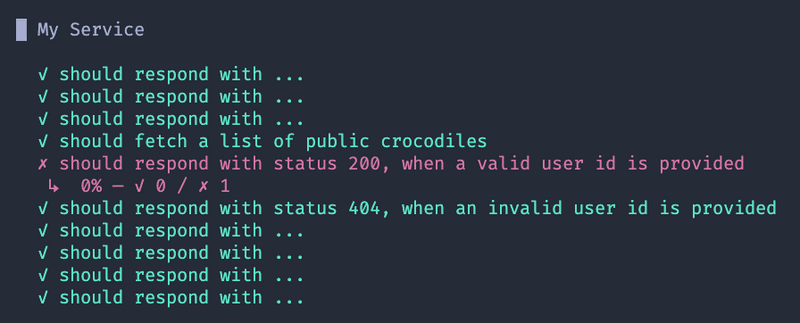The growth of a code base is unpredictable. To account for this uncertainty, we call on everything we've learnt in the last x years about how to scale an application effectively: adopting naming conventions, creating file and folder structures, using the latest patterns, and producing sensible abstractions. These actions add up over time. Eventually, you'll mentally high-five your past self for having taken the time to do them ✋.
Your tests should be future-proof too. But, along with the typical development best practices, testing requires some unique strategies to scale with the application, all whilst making sure that the test itself is stable, predictable, and adds some value by providing confidence that it's working the way it should, not just raising your coverage score.
Out of the box, k6 provides the beloved check function. Yes, it does the job, but it does very little to organise our tests into a structure that we can navigate with ease, an absolute must for larger applications.
These days, most Javascript developers use test frameworks such as Jest, Jasmine, or Mocha and Chai. They enforce conventions that require the user to name their tests and provide human-readable expectations for the results. We wanted to offer that same level of familiarity, so we wrote something we think you might like.
A k6 library for ChaiJs
We would like to share that k6 has released k6chaijs! This library comes with Chai built-in and some extras to make it play nicely with k6.
Getting to know chai
Chai is a BDD / TDD assertion library for node and the browser that can be delightfully paired with any javascript testing framework.
If you're not familiar with the terms BDD and TDD, here is a quick summary.
Behavior Driven Development (BDD): The use of human-readable descriptions of software requirements as the basis for software tests.
Test-driven development (TDD): A process that creates software test cases before building the application, so the software can be iteratively developed until all test cases pass.
Reasons to use an assertion library
Expressive language
By writing tests in Chai, you can use expressive language to avoid code interpretation. Just think about having to read through hundreds of tests like this:
How would you even find them!? 😰
Let's take a look at a simple test written using Chai. What do you think the following code expects?
Easy! It expects the string Hello to have a length of 5.
Automatic messages
Tired of writing test descriptions and error messages? Assertion libraries have you covered, with automatically generated messages!
Structure
Through encapsulation, your tests can define sections for your application. This makes it easier to:
- Locate tests
- Spot missing edge cases
- Keep everything tidy
- Provide a logical format for adding additional tests.
Discoverability
Imagine an application with hundreds of tests and a mostly green test summary. "Mostly" green means it has some failures.
To track down these failures, you can copy the test name, search your test project for a match, and immediately narrow down which part of the application is failing.
However, for this to work, you need neatly structured tests and unique, descriptive test names.
Flexibility
Although an assertion library is typically used to write mocked unit/integration tests, that doesn't mean we can't use it to test our API responses.
Stability
By itself, the k6 check function is not enough to protect your tests against unsafe code. When your system is under load it is possible for some requests to start failing.
Fortunately, with k6chaijs error handling is provided automatically. Script errors are caught by the describe block and execution can proceed to the next set of tests.
Using k6 with chai
Let's look at an example script and its end-of-test summary.
The script
The following script incorporates thresholds with 3 test cases that use Chai:
- One describe function creates sections and groups tests together
- Another describe provides clear instructions on what we hope to achieve from each test
- Chai's BDD-style expect function is used to write the tests in an expressive, readable way
Under the hood
If you were wondering how this all works, the explanation is pretty straightforward.
describe
k6 users will use the group function to perform this type of operation, however, for users of Javascript testing frameworks, describe is the familiar term. It still calls group, but it's wrapped with a little bit of extra logic.
expect
As you might have already guessed, Chai's expect function has been modified to include some k6 goodness with the eventual execution of the check function.
Why am I telling you all this? Well, because we're leaning on the k6 functions group and check to categorise and test our APIs.
k6 users benefit from using a powerful assertion library, but they'll still get the output summaries they know and love ❤️.
The summary
Let's see how all this hard (well, not really) work translates to the output summary:
- All tests are grouped nicely together, with clear descriptions
- Each assertion is clearly labelled
- Each assertion has passed, so the overall test has succeeded!
For cloud users, the results are going to display just as they normally would, under the checks tab.
Achievement unlocked 🥳
We've seen how an assertion library like Chai with k6 can make reading and writing tests more manageable, which becomes increasingly important as an application scales. It also makes tests easier to comprehend for everyone, not just testers and engineers.
Future plans
- Release as an npm package.
- Provide more ways to structure tests.
- Create additional custom assertions.
Get involved
If you're interested in contributing, you can find k6chaijs on Github. We hope you enjoy using this library and look forward to receiving your feedback!


